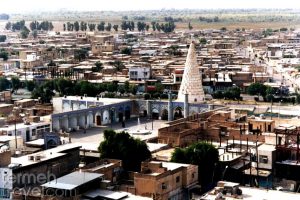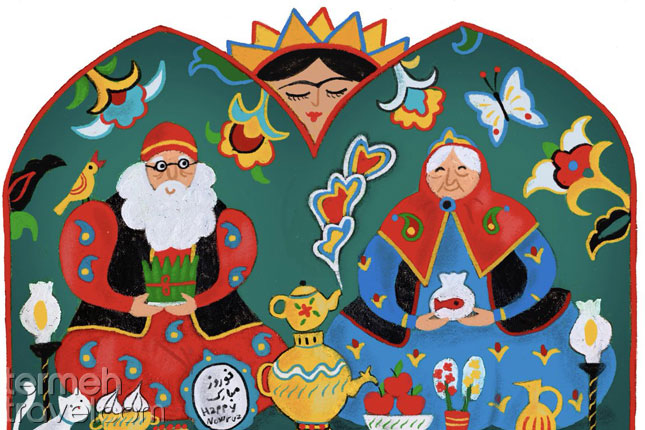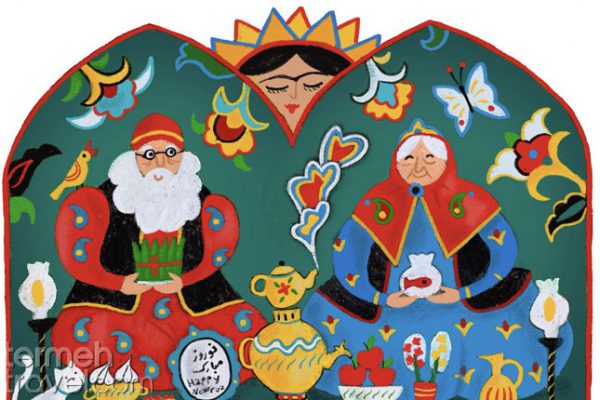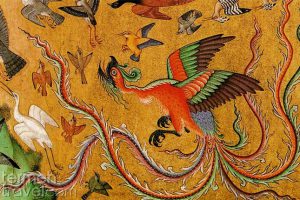Watching a Ghalamkari work is like stepping inside a fictional book full of different stories. By looking at the floral patterns, you can imagine yourself in a garden, touching the flowers and smelling their scent. You will also follow a Persian soldier hunting on his horse among the cedar trees. The natural color of a Ghalamkari fabric displays a fetching part of Persian Art. No matter what the story is, the road that leads you to see Persian art and culture is always exciting.
Table of Contents
What Is Ghalamkari?
In the Persian language, “Ghalam” means pen and “Ghalamkari” is the art of painting with a pen or stamping on a piece of fabric, especially clothes. A “Ghalamkar” or the master of this art, uses natural materials to illustrate Persian art on a piece of cloth and offers you this souvenir to bring back to your home. You can even use a Ghalamkari work as a tablecloth and enjoy its design.
If we take a look at Persian art’s history, Ghalamkari wan not very popular in ancient Iran, but eventually, this form of art found its place among Iranians during the Safavid dynasty. During that era, this art showed its perfection and still shines in Isfahan more than other places in Iran to be one of the main handicrafts in this fabulous city. The ultimate beauty of Ghalamkari was irresistible, therefore even the attack of Mongol’s army to Iran could not destroy this art. The magical nature of it enchanted the Mongol army and let them enjoy it as well.
Since the capital of Iran during the Safavid dynasty was Isfahan, the masters of Ghalamkari carried over this precious art to their children and grandchildren. Thankfully this art could stay alive and show Iranians’ delicate and artistic nature to the world.
What Are the Main Elements of Ghalamkari?
Like some other traditional Persian arts such as plaster works, wood carving, and tile works, Ghalamkari is about the lines, inspirations from nature, and professional artists to transfer their aesthetic spirit through their hands and display their limitless abilities on fabric.
Patterns in Ghalamkari
The main patterns in Ghalamkari works are inspired by nature. You can find different flowers and trees which are symbolic in the Persian Culture inside this form of art. The cedar tree is one of the patterns which is the resemblance of life and livelihood. The Islamic flowers and paisley design is evident, as well. The smooth curves of these floral patterns can show the delicacy of Iranian art.
You can find the hunting scenes in Ghalamkari works as well. The miniature pattern of a Persian prince with a bow and arrow on his hand while riding on a horse and chasing a gazal can be craved in your mind.
All of these patterns shows how Iranians value nature and its beauty. For Iranians, using Ghalamkari is an excellent way of showing respect to Mother Nature.
What Are Ghalamkari Materials?
Ghalamkari is one of the most elegant forms of Persian art. Therefore, the materials need to be elegant too. The main materials come from nature. Each thread and color has a natural base, which adds to its value. However, due to the massive product of Ghalamkari, today, people use chemical materials as well to keep the price low and increase the production amount.
Colors in Ghalamkari
The most used colors in a Ghalamkari work are pail red, black, blue, and yellow. The masters extract the color from natural sources. For example, in order to have red, Iranians used red roses. By using walnuts’ peels, the black color could be found. However, today, chemical colors are more popular, so the diversity of shades in this art increased as well.
Fabric in Ghalamkari
Silk and cotton are the two main fabrics in Ghalamkari. These two types of fabrics offer paintability, which allows them to absorb different colors better, and can save their shapes for a long time. However, today the cloth does not need to be totally pure. To make affordable Ghalamkari works, companies use a combination of different qualities of cotton.
Tools in Ghalamkari
Many years ago, the artists only needed colors, fabric, and brushes, in order to create a Ghalamkari work. They could draw every pattern using different sizes of brush made of horsehair and by hand. Then the artist required to color the patterns patiently. However, nowadays, Iranians invented some stamps made of carved pear or hawthorn wood to enhance the process.
How Do Iranians Produce a Ghalamkari Work?
First of all, the background of the work or the fabric needs to be colored. By putting the cotton fabric inside a bowl of water and pomegranate peels, the material will have a light beige color that is perfect for drawing. Isfahan’s Zayandeh Roud river was used as the place to soak the fabrics for about five days to have a smooth colored fabric. When the sun rays dry the fabric completely, the “Ghalamkar” or the artist can draw on the fabric by a brush or use wooden stamps.
The first stamp that should be used on the fabric is the black outline to put the desired pattern on the cloth. Then the artist needs to color the second stamp and place it precisely on the first one and hammer it. Any changes in the placement of the second stamp can decrease the value of the Ghalamkari work. Then the Ghalamkars can use as many colors as they want and put the stamps on the fabric to have a colorful piece of cloth.
After finishing the coloring process, the artist needs to fix the colors for washing by cooking them. The Ghalamkar should have a pot full of boiling water and use the steam of the water to heat the colors, cook them, and wash them once again. When the fabric is dried fully, the final touch of the artists is designing the edges of the Ghalamkari. Finally, this gorgeous piece of art is ready to design your house with its astonishing patterns and colors.

Having an elegant Ghalamkari work in your house can remind you of the rich Persian culture and the beauties of Iran. You can always travel to Iran, visit Isfahan and explore Naqsh-e Jahan Square to buy your Ghalamkari work there.
Works Cited:
Ghareh Nezhad, Hossein. Ghalamkari Fabrics, 1977













Leave a Comment